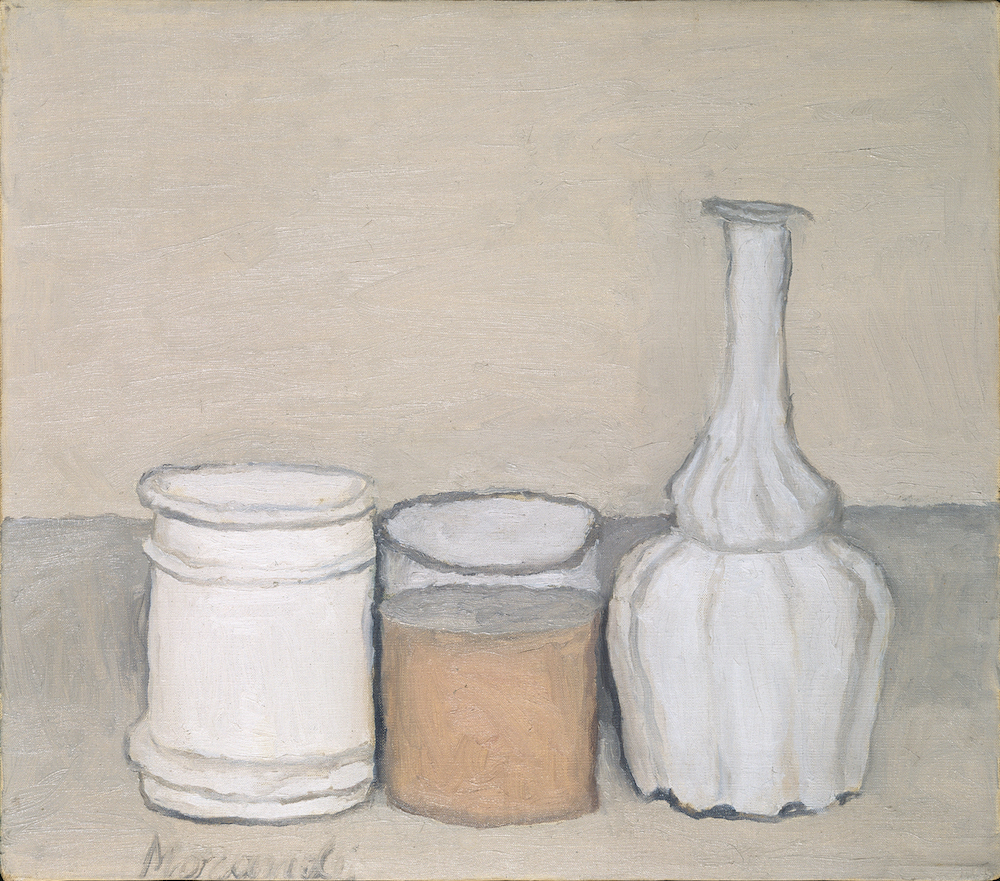For the blind man in the dark room ...
Contemporary Art Museum, St. Louis, USA
Contemporary Art Museum, St. Louis, USA

The cat had it right from the start. ‘Is this one a good painting? Does it correspond with what you would expect from the recent transformation from Conceptual art to this new version of a certain kind of figuration, one could say?’ After a pause, the cat replies with an uncertain ‘Mew.’ ‘You think so?’ This time it responds with four lengthy ‘Meow’s. Little did Marcel Broodthaers’ cat know that Interview With A Cat (1970) would be shown alongside still lifes by Giorgio Morandi, brought together in the sprawling group show ‘For the blind man in the dark room looking for the black cat that isn’t there’. Morandi’s 50-year career – spent repetitively depicting tabletops of jars, glasses and vases – was here represented by two small canvases, the only paintings in the exhibition, surrounded by photographs, videos, drawings and sculptures. The cat’s responses, yearning and mournful, seemed to me to echo the depth and doubt of Morandi’s work.
The show, curated by Anthony Huberman, took its title from a line attributed to Charles Darwin: ‘A mathematician is like a blind man in a dark room looking for a black cat that isn’t there.’ Intending to celebrate this speculation on the unknown, the exhibition presented 22 artists working with a range of methods and means of delving into the (metaphorical) darkness. Without making too much of the fact that, aside from Broodthaers’ piece, all the work relied on the visual realm and exuded an assured physicality, there is also a touch of voyeuristic sadism to Darwin’s line – for the blind man it is, of course, irrelevant that the room is dark and the cat is black. But the title allows us to see what the blind man cannot. The privilege of choosing whether or not to see divided the participating artists: those for whom the point was the act itself of groping around in the dark, and those for whom the emphasis was more on what they had found there.
Hans-Peter Feldmann’s visual pun One Pound Strawberries (2003) – 34 individual photographs of the fruit that would make up the total weight of a pound – parodied attempts to categorize and control the world around us. Rachel Harrison enacted a similar mock taxonomy with ‘The Voyage of the Beagle, Two’ (2008), a photographic series of 58 portraits and effigies, from a plastic Elvis, to SpongeBob SquarePants’ starfish friend Patrick and anthropomorphic stone faces. This quasi-anthropological survey seemed out of place, though, a kind of search unrelated to the exhibition’s existential uncertainties.
Near the entrance to the show, the organizers used a 1672 illustration of a cabinet of curiosities, a precursor to the modern museum, to ‘remind us that museums have long offered a space to enjoy the discovery of extraordinary things we do not understand.’ What they didn’t mention, however, was that museums were also markers of wealth and the result of imperialist conquest. Casting the whole exhibition as a de-politicized Wunderkammer created a twofold effect: on the one hand, it threatened to drag the work of the artists into appearing merely as a sort of exotic whimsy; on the other, it tacitly promoted a set of Enlightenment values that connected seeing to knowledge and power.

There was a handful of blind, groping artists who fortunately undermined this effect. An untitled installation (1971–2009) by Matt Mullican covered two walls in drawings, clippings and scrawled observations, light-heartedly and apparently endlessly attempting to define the discrepancy between reality and representation. In one simple black and white line drawing, a pair of glasses and a brush sit on a table above the subtitle: ‘A pair of real objects on a fictional table.’
Frances Stark and Falke Pisano came across particularly well here, with works that carefully undid their own certainties, leaving imaginative space for the viewer within their open-ended explorations. Pisano’s Chillida (Forms and Feelings) (2006) is an incisive and personal phenomenology of Modernist sculpture, as she narrated over a dual projection her own shifting feelings about a photographic series of works by the Basque sculptor Eduardo Chillida. In the end, she admits: ‘Whenever I tried to become more specific, it seemed like I lost the most important element of my affection,’ letting her observations remain temporary and ephemeral. The unrolling poster of Stark’s ongoing text work I must explain (again) (2009) likewise unravels, including itself when it questions the unitary meaning of any work – how its coherence can be dissipated by a passing fly or by the ringing of a telephone.
Writing for the ‘Nought to Sixty’ programme at the ICA, London, last year, Sarah Pierce wrote of ‘the institutional impulse to thematize difficult concepts and deliver them with ease, to effectively synthesize and “do” knowledge without undoing how we know’. Ambiguity and darkness are necessary for the creative moment but not easily pinned down, and here almost chased away entirely. With a mixture of exhilaration, humour and violence, Mariana Castillo Deball’s sculpture Klein Bottle Piñata (2009) provided perhaps the best analogy for revelling in a search for the unknown. Deball constructed a piñata to resemble a Klein bottle – a mathematical object that looks like a bottle, but the surface of which is both its own ‘inside’ and ‘outside’. An impossible shape that cannot be fully realized in the third dimension (in Deball’s sculpture, the point at which the bottle’s ‘handle’ is supposed to intersect with itself didn’t actually intersect), it waited for the exhibition’s final day for blindfolded participants to wave their arms about in the attempt to connect with the object: some tried to crack it open to find out what was hidden inside while others simply relished the dark.
























